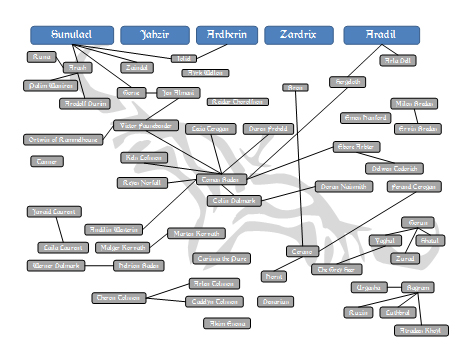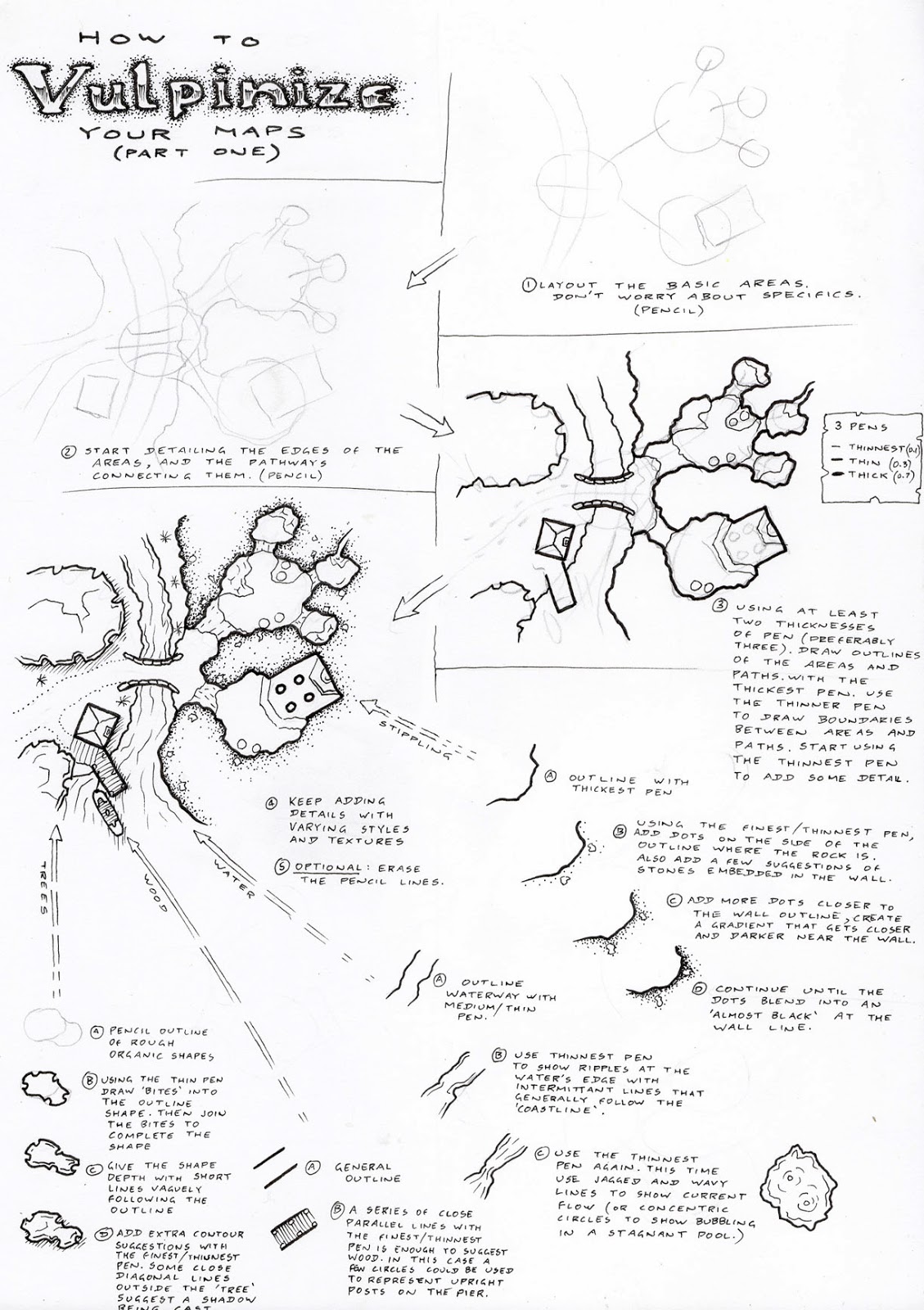Modular Gaming Components 3 - The Relationship Map
Apparently, according to some sources, the first game to do this really well was Sorceror (written by Ron Edwards and published by Adept Press)...but I distinctly remember seeing implementations of relationship maps back in World of Darkness games in the 90s.
The idea is that different characters in the story are connected to each other, Points (or nodes) on the chart indicate who they are, and lines between them can be used to indicate who connects to whom...but there can be more than this.
Relationship maps can be simple...
...or quite complicated...
They can link only the characters in a campaign, or they can link characters to places, and to objects that may be important to the story. The links can also depict more than just a connect between elements of the setting. I like to add symbols to the lines between nodes, or colour code them.
In this case, the nodes are groups, because these are the important units of the story. Within each group there could be a separate relationship map for how the specific members relate to one another, but that's a level of complexity we don't particularly need in the story (yet). I usually try to make sure the core group (or core characters) in a game are at the centre of the map, since this gives the most space for connections to the peripheral characters of story elements. The colour coding that I'm using is fairly common to the colour coding I use in most of my maps. Some groups have neutral attitudes to others, some like other groups, some dislike them...and some want another group eliminated. However, notice that many of the lines between groups have different colours on each end. For example, at the bottom, the Domain of Sydney is aiming a black arrow at the Court of Dreams indicating that they want the group dead... meanwhile the Court of Dreams is aiming a grey arrow at the Domain of Sydney indicating that they don't really care about the domain one way or the other. This suggests that the court knows of the domain, but maybe doesn't see them as a legitimate threat, or just isn't sure of the best way to deal with them...while the domain considers the court dangerous enough to be a threat, or at least in their way as a obstacle toward a goal that they want. This sets up an interesting tension that characters can explore through the game.
Relationship maps work really well when considering the intentions and agendas of non-player characters in the game, and even though they may shift over the course of play depending on the actions taken by player characters, they can set up good reasons for NPCs to have specific first impressions of player characters.
In my example above, the Highway Patrol don't care too much about the Newcastle Vampires, but the Newcastle Vampires don't like the highway patrol. In the context of a Vampire the Masquerade game, this could easily be explained by the Highway Patrol doing their own thing and occasionally breaching the masquerade the keeps humans unaware of the existence of supernatural beings in the world. The Newcastle Vampires still adhere generally to the masquerade and keep a low profile as they manipulate the world around them, and they see the Highway Patrol as a threat to that status quo. The Sydney Court doesn't care too much about the Highway patrol, seeing them as little more than annoying children who are making trouble for their enemies among the Newcastle Vampires. The Highway Patrol have a historical dislike for he Sydney Domain, because they're predominately ex-Sabbat, and therefore traditional rivals to the nominally Camarilla vampires who live in Sydney.
If the player characters walk into this situation, the actions they take with regard to one group will instantly have ripple effects across the map.
- If the early actions of the game see the players make an alliance with the Newcastle Vampires, they'll instantly make enemies from the Sydney Domain. The Highway Patrol will be wary, but reserve judgement until the player characters have made some kind of action that influences them.
- If the early actions cause them to make enemies with the Newcastle Vampires, the Sydney Vampires will be wary but may consider the enemy of their enemy to be a potential ally of convenience (or may play nice while considering the player characters to be a new tool/toy). The Highway patrol will still be wary.
- If the early actions see positive relations with the Highway Patrol, the Newcastle vampires might see the player characters as a new enemy, or they might see them as a useful tool to leverage and control the Highway Patrol. Postitive relations with the Highway Patrol might scare the Sydney Domain, under the premise that more young vampires will destabilise the local area (and they really don't like that sort of thing unless they're the ones causing the instability).
- If the early actions make enemies from the Highway Patrol, the Newcastle vampires might sponsor the player characters to cause more trouble for the nomadic group. In this case, the Sydney Domain will be wary and will probably take a "wait-and-see" attitude before deciding how to deal with the player characters.
- If the early actions prompt alliances with the Sydney Domain, then the Newcastle Vampires and Highway Patrol will instantly adopt a war footing against the player characters. Things will get bloody and fast...and the Sydney Domain might not be able to send enough forces to help them (leaving the player characters as acceptable collateral damage in the eternal war).
- If the early actions see them make enemies with the Sydney Domain, both the highway patrol and the Newcastle Vampires will treat the cautiously, but probably offer assistance to a new group who might potentially tip the balance in their favour.
This isn't even taking into consideration the other groups on the relationship chart.
The Werewolves won't care what happens when alliances or animosities are struck with the Sydney Domain, because those vampires are out of their territory. But they will become interested in the players establish positive or negative relations with the Newcastle Vampires or the Highway patrol.
The Court of Dreams are more interested in the spirit world, and don't care about interactions with the Highway Patrol. If the player characters interact with the Newcastle Vampires or Sydney Domain, they'll start to step into events.
So we basically end up with an effect that any time the player characters make an ally out of someone, they'll probably make an enemy out of someone else...and any time the player characters make an enemy out of someone, everyone else will sit back and see what happens. This means it usually pays to make friends, because you get the benefit of the friendship offset by a new enemy. If you just make enemies, you end up with people wanting you dead, and probably don't get a benefit in the form of new allies or the support they may offer.
(Murder-hoboes get a lot of people wanting them dead, and a lot of other people eating popcorn while they watch the murder-hoboes end up in sticky situations of their own creation.)
The whole thing prompts a more strategic and diplomatic style of play which really works for games like Vampire.
An alternative way to track things with relationship maps works better on an individual basis. Instead of just showing who likes or dislikes each other. You can add numbers to the lines, and an arrow on those numbers. The numbers would represent boons or favours. A line with a zero would not have a direction on it, and would indicate that the two folks on the chart know each other in some way but neither of them is in debt to the other. A 1 would have a direction, indicating that one person owes a minor favour to the other (the character owed the favour is the one pointed to). A 2 (also with direction) would indicate a major favour owed), and a 3 might be a life debt. In this situation, any time a character is killed in the game, and favours owed to them are instantly negated, but any favors that character owes to others are immediately transferred to the killer. Things get complicated fast in a set-up like this, but that's the whole point and in reinforces the idea that actions have consequences without needing to rely on police, town guards, hunters, karmic effects of alignment, or intervention of divine forces. (Yes...it's just another way of reducing the impact of murder-hoboes, because every time they kill someone they find themselves in debt to someone else, so it probably pays to make sure if you kill someone you're getting something out of it, like a favour or two from someone else.)





.png)
Comments